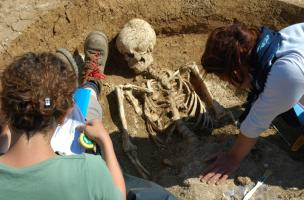You are here
The A19 motorway. Bodies offered to the Gods.
At the point where the Beauce and Gâtinais regions meet, a team of 60 Inrap archaeologists is currently excavating the site of the future A19 motorway between Artenay and Courtenay (Loiret). Curated by the Ministry of Culture (Drac région Centre), this research is financed by Arcour, the future motorway operator. Of the 1,300 hectares of land concerned, over 90% has already been explored. Among the one hundred or so sites identified, that of Neuville-aux-Bois has yielded numerous structures. Enclosures, ditches, insubstantial buildings and granaries have been excavated.
Most of these structures date from two periods of the Second Bronze Age (La Tène culture): one around 450 BC, the other at the end of the 2nd century and during the 1st century BC.
The agricultural nature of this Celtic site is confirmed by the presence of numerous silos, large underground storage pits, which were hermetically sealed to assure the conservation of harvested cereals.
At Neuville-aux-Bois, seven of the fifteen silos contain eight human corpses.
From relegation grave to "silo-offering”
Mahaut Tyrrell
Media communication
Inrap, media partnerships and relations
+33 6 07 40 59 77
mahaut.tyrrell [at] inrap.fr




